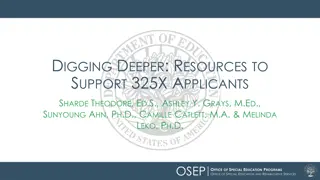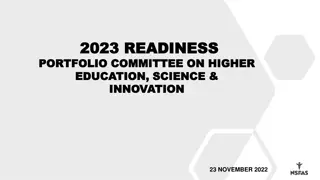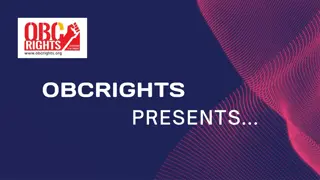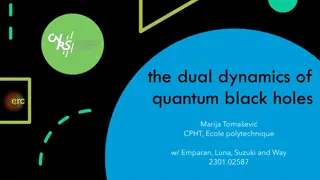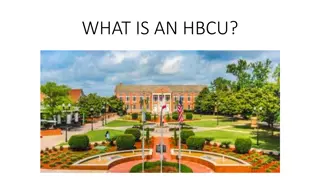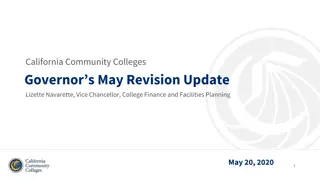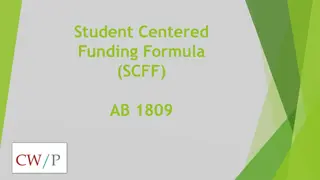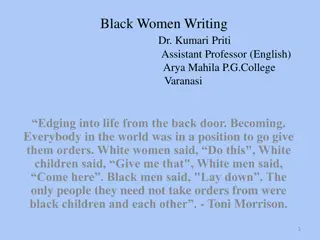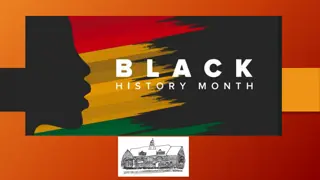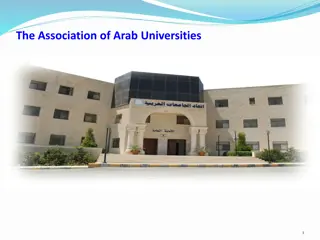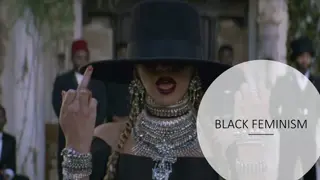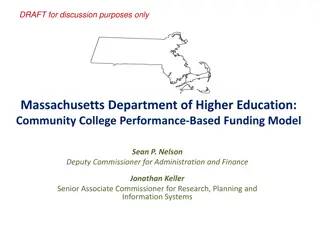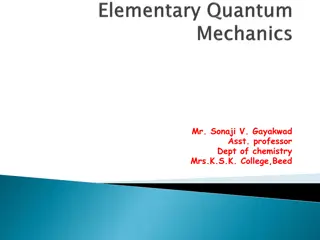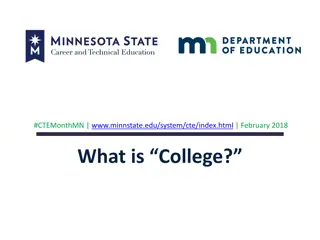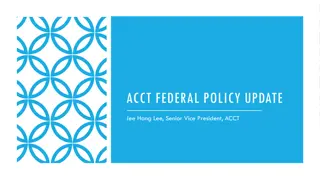Recent Developments in Funding for Historically Black Colleges and Universities
Recent legislation, including the FUTURE Act, has provided significant mandatory funding for Historically Black Colleges and Universities (HBCUs) and minority-serving institutions. The Title III programs, under the Strengthening HBCU initiative, receive discretionary grants determined by a formula calculation, ensuring support for these educational institutions. The focus is on fostering undergraduate talent and ensuring sustainable funding for HBCUs.
Download Presentation

Please find below an Image/Link to download the presentation.
The content on the website is provided AS IS for your information and personal use only. It may not be sold, licensed, or shared on other websites without obtaining consent from the author. Download presentation by click this link. If you encounter any issues during the download, it is possible that the publisher has removed the file from their server.
E N D
Presentation Transcript
HISTORICALLY BLACK COLLEGES AND UNIVERSITIES DIVISION
HBCU-PBI DIVISION Title III Part B Strengthening Historically Black Colleges and Universities Title III Part F Strengthening Historically Black Colleges and Universities Title III Part B Strengthening Historically Black Graduate Institutions Minority Science and Engineering Improvement Program Master s Degree Programs at Historically Black Colleges and Universities Predominantly Black Institutions - Competitive Grants Predominantly Black Institutions - Formula Grants
TABLE OF CONTENTS 1. Highlights from Recent Legislation 2. Legislation, Regulations, and Uniform Guidance 3. Legislative Allowable Activities 4. Goals and Objectives Measurability 5. Application Requirements 6. Comprehensive Development Plan
HIGHLIGHTS FROM RECENT LEGISLATION
HIGHLIGHTS FROM RECENT LEGISLATION Fostering Undergraduate Talent by Unlocking Resources for Education Act or the FUTURE Act. The Future Act removed all of the words after $255,000,000 and replaced them so that 371(b)(1)(A) now reads as follows: H.R. 5363, the FUTURE Act (enacted 2/19/2019) Makes permanent $255 million in mandatory funding for historically Black colleges and universities and other minority-serving institutions (Title III, Part F); Provision of funds. There shall be available to the Secretary to carry out this section, from funds in the Treasury not otherwise appropriated, $255,000,000 for fiscal year 2020 and each fiscal year thereafter. Prior to the Future Act Section 371(b)(1)(A) read: No other changes were made to the Act. So, the other terms/conditions relating to grants under Section 371 still apply. Provision of funds. There shall be available to the Secretary to carry out this section, from funds in the Treasury not otherwise appropriated, $255,000,000 for each of the fiscal years 2008 through 2019. The authority to award grants under this section shall expire at the end of fiscal year 2019. The effect of the change is to guarantee funding for the programs authorized in Section 371 beginning in FY 2020 and continuing unless/until Congress changes the law.
DISCRETIONARY GRANT MANDATORY The Title III Strengthening Historically Black Colleges and Universities (HBCU) Programs are discretionary grants, however the awards are determined by using a formula calculation established via statute. Congress has required the level of funding for each recipient to be determined by calculating formula elements specifically outlined in the legislation and the program regulations without a competitive process involved.
LEGISLATION, REGULATIONS, AND UNIFORM GUIDANCE
Legislation, Regulations and Uniform Guidance Title III, Part F, Strengthening Historically Black Colleges and Universities Section 371 of the Higher Education Act, as amended (20 U.S.C. 1067q) WHAT IS THE PROGRAM LEGISLATION? EDGAR Title 34 CFR Education Department General Administrative Regulations (EDGAR), Parts 74, 75, 77, 79, 81, 82, 84, 85, 86, 97, 98, and 99 WHAT ARE THE PROGRAM REGULATIONS? Uniform Guidance Title 2 Code of Federal Regulations (CFR) Part 200 Uniform Administrative Requirements, Cost Principles, and Audit Requirements for Federal Awards
LEGISLATIVE ALLOWABLE ACTIVITIES (LAAS) (Authority: 20 U.S.C. 1062)
How to use grant funds? ALLOWABLE ACTIVITIES (20 U.S.C. 1062) What activities are allowed? Can funds be used for travel?
TITLE III, PART F, STRENGTHENING HISTORICALLY BLACK COLLEGES AND UNIVERSITIES SECTION 371 OF THE HIGHER EDUCATION ACT, AS AMENDED (20 U.S.C. 1067q) (Formerly known as SAFRA) 1067q. Investment in historically Black colleges and universities and other minority- serving institutions (C) ALLOCATIONANDALLOTMENT HBCUS AND PBIS From the amount made available for allocation under this subparagraph by subparagraph (A)(ii) for any fiscal year- (i) 85 percent shall be available to eligible institutions described in subsection (a)(1) and shall be made available as grants under section 1062 of this title and allotted among such institutions under section 1063 of this title, treating such amount, plus the amount appropriated for such fiscal year in a regular or supplemental appropriation Act to carry out part B of this subchapter, as the amount appropriated to carry out part B of this subchapter for purposes of allotments under section 1063 of this title, for use by such institutions with a priority for- (I) activities described in paragraphs (1), (2), (4), (5), and (10) of section 1062(a) of this title;
1062. Grants to institutions (a) General authorization; uses of funds From amounts available under section 1068h(a)(2) of this title for any fiscal year, the Secretary shall make grants (under section 1063 of this title) to institutions which have applications approved by the Secretary (under section 1063a of this title) for any of the following uses: (1) Purchase, rental, or lease of scientific or laboratory equipment for educational purposes, including instructional and research purposes.
1062. Grants to institutions (a) General authorization; uses of funds From amounts available under section 1068h(a)(2) of this title for any fiscal year, the Secretary shall make grants (under section 1063 of this title) to institutions which have applications approved by the Secretary (under section 1063a of this title) for any of the following uses: (2) Construction, maintenance, renovation, and improvement in classroom, library, laboratory, and other instructional facilities, including purchase or rental of telecommunications technology equipment or services.
1062. Grants to institutions (a) General authorization; uses of funds From amounts available under section 1068h(a)(2) of this title for any fiscal year, the Secretary shall make grants (under section 1063 of this title) to institutions which have applications approved by the Secretary (under section 1063a of this title) for any of the following uses: (4) Academic instruction in disciplines in which Black Americans are underrepresented.
1062. Grants to institutions (a) General authorization; uses of funds From amounts available under section 1068h(a)(2) of this title for any fiscal year, the Secretary shall make grants (under section 1063 of this title) to institutions which have applications approved by the Secretary (under section 1063a of this title) for any of the following uses: (5) Purchase of library books, periodicals, microfilm, and other educational materials, including telecommunications program materials.
1062. Grants to institutions (a) General authorization; uses of funds From amounts available under section 1068h(a)(2) of this title for any fiscal year, the Secretary shall make grants (under section 1063 of this title) to institutions which have applications approved by the Secretary (under section 1063a of this title) for any of the following uses: (10) Establishing or enhancing a program of teacher education designed to qualify students to teach in a public elementary or secondary school in the State that shall include, as part of such program, preparation for teacher certification.
1067q. Investment in historically Black colleges and universities and other minority-serving institutions (C) ALLOCATIONANDALLOTMENT HBCUS AND PBIS From the amount made available for allocation under this subparagraph by subparagraph (A)(ii) for any fiscal year- (i) 85 percent shall be available to eligible institutions described in subsection (a)(1) and shall be made available as grants under section 1062 of this title and allotted among such institutions under section 1063 of this title, treating such amount, plus the amount appropriated for such fiscal year in a regular or supplemental appropriation Act to carry out part B of this subchapter, as the amount appropriated to carry out part B of this subchapter for purposes of allotments under section 1063 of this title, for use by such institutions with a priority for- (II) other activities, consistent with the institution's comprehensive plan and designed to increase the institution's capacity to prepare students for careers in the physical or natural sciences, mathematics, computer science or information technology or sciences, engineering, language instruction in the less- commonly taught languages or international affairs, or nursing or allied health professions;
GOALS AND OBJECTIVES MEASURABILITY
What makes an objective measurable? What is a measurable objective? Measurable objectives answer the following questions: A measurable objective is the quantitative means used by the Department to determine if substantial progress is being made in a grant award. Who? Who is involved in the change being proposed? What? What is the outcome expected? When? When will this be accomplished? How? How will progress be measured? Proficiency? What is the criteria for success?
GOALS OBJECTIVES Meaning The purpose toward which an endeavor is directed. Something that one's efforts or actions are intended to attain or accomplish; purpose; target. G O A L S Example The institution will purchase new equipment including software and computers as well as provide training for faculty and students to transition to virtual classes. Twenty percent per year will be completed over the five-year grant period. VS . Action The action is the task in which you will carry out the activity. Specific action - the objective supports attainment of the associated goal. O B J E CT I VE S ( HTTP://DICTIONARY.REFERENCE.COM/) Measure Activities may not be strictly measurable or tangible. Must be measurable and tangible. Time frame Longer term Mid to short term https://www.diffen.com/difference/Goal_vs_Objective
What does a measurable objective look like? For Example: By the end of the program year, we will increase virtual classrooms for the academic curriculum by 95%. MEASURABLE OBJECTIVES VS. What does a non-measurable objective look like? For Example: The HBCU College will establish virtual classrooms. What is a task? A task is the action/work that needs to be done/ completed to achieve your objective. TASKS For Example: During year 2020, the HBCU College faculty will identify software programs to assist with online courses and teach virtual classrooms for all academic curricula to students. https://www.diffen.com/difference/Goal_vs_Objective
Can we use grant funds for travel? Yes, BUT For ALL travel, the travel must be clearly related to the goals and objectives outlined in the CDP. The knowledge gained should highly benefit the institution (not just those who are traveling) and should be specialized. Federal regulations concerning travel apply (see OMB Circular A-21). ALL REQUESTS FOR INTERNATIONAL TRAVEL must be submitted to ED for approval. Requests for international travel are being evaluated on a case-by-case basis.
APPLICATION REQUIREMENTS (AUTHORITY: 20 U.S.C. 1063, 1063A AND 1066(B)(2))
APPLICATIONS (20 U.S.C. 1063A(a)) (a) Contents No part B institution shall be entitled to its allotment of Federal funds for any grant under section 1063 of this title for any period unless that institution meets the requirements of subparagraphs (C), (D), and (E)1of section 1058(b)(1) of this title and submits an application to the Secretary at such time, in such manner, and containing or accompanied by such information, as the Secretary may reasonably require. Each such application shall (1) provide that the payments under this chapter will be used for the purposes set forth in section 1062 of this title; and (2) provide for making an annual report to the Secretary and provide for (A)conducting, except as provided in subparagraph (B), a financial and compliance audit of an eligible institution, with regard to any funds obtained by it under this subchapter at least once every 2 years and covering the period since the most recent audit, conducted by a qualified, independent organization or person in accordance with standards established by the Comptroller General for the audit of governmental organizations, programs, and functions, and as prescribed in regulations of the Secretary, the results of which shall be submitted to the Secretary; or (B) with regard to an eligible institution which is audited under chapter 75 of title 31 deeming such audit to satisfy the requirements of subparagraph (A) for the period covered by such audit.
APPROVAL (20 U.S.C. 1063A(a)(b)) (b) Approval The Secretary shall approve any application which meets the requirements of subsection (a) and shall not disapprove any application submitted under this part, or any modification thereof, without first affording such institution reasonable notice and opportunity for a hearing. (c) Goals for financial management and academic programs Any application for a grant under this part shall describe measurable goals for the institution's financial management and academic programs and include a plan of how the applicant intends to achieve those goals.
SUBMITTING AN APPLICATION (AUTHORITY: 20 U.S.C. 1063, 1063A AND 1066(B)(2)) a) A description of the activities to be carried out with grant funds; b)(b) A description of how the grant funds will be used so that they will supplement and, to the extent practical, increase the funds that would otherwise be made available for the activities to be carried out under the grant and in no case supplant those funds; c) (1) A comprehensive development plan as described in 608.21; or (2) If an applicant has already submitted a comprehensive development plan as described in 608.21, a description of the progress the applicant has made in carrying out the goals of its plan; d)An assurance that the institution will provide the Secretary with an annual report on the activities carried out under the grant; e) An assurance that the institution will provide for, and submit to the Secretary, the compliance and financial audit described in 608.41; f) An assurance that the proposed activities in the application are in accordance with any State plan that is applicable to the institution; g) The number of graduates of the applicant institution during the school year immediately preceding the fiscal year for which grant funds are requested; and h) The number of graduates of the applicant institution (1)Who, within five years of graduating with baccalaureate degrees, attended graduate or professional schools and enrolled in degree programs in disciplines in which Blacks are underrepresented during the school year immediately preceding the fiscal year for which funds are requested; and (2) Who graduated with baccalaureate degrees during any one of the five school years immediately preceding the school year described in paragraph (h)(1) of this section.
COMPREHENSIVE DEVELOPMENT PLAN (Authority: 20 U.S.C. 1063a)
COMPREHENSIVE DEVELOPMENT PLAN a) A comprehensive development plan must describe an institution's strategy for achieving growth and self-sufficiency by strengthening its (1) Financial management; (2) Academic programs; and b) The comprehensive development plan must include the following: (1) An assessment of the strengths and weaknesses of the institution's financial management and academic programs. (2) A delineation of the institution's goals for its financial management and academic programs, based on the outcomes of the assessment described in paragraph (b)(1) of this section. (3) A listing of measurable objectives designed to assist the institution to reach each goal with accompanying timeframes for achieving the objectives. (4) A description of methods, processes, and procedures that will be used by the college or university to institutionalize financial management and academic program practices and improvements developed under the proposed funded activities.
REQUIRED DOCUMENTATION AND ATTACHMENTS Narratives describing your justification for program; Identify which activity (LAA) your project relates to; Budget Narrative outlining the budget line items and identify the cost associated with each; Program Activity narrative describing the activities you will submit in the CDP; Personnel must include (1) a current outline of current personnel and what positions will be included; (2) resume of person of interest, and (3) a copy of the job description; Combine your activity and budgets into one submission.
QUESTIONS CONTACT THE OFFICE OF SPONSORED PROGRAMS/TITLE III










